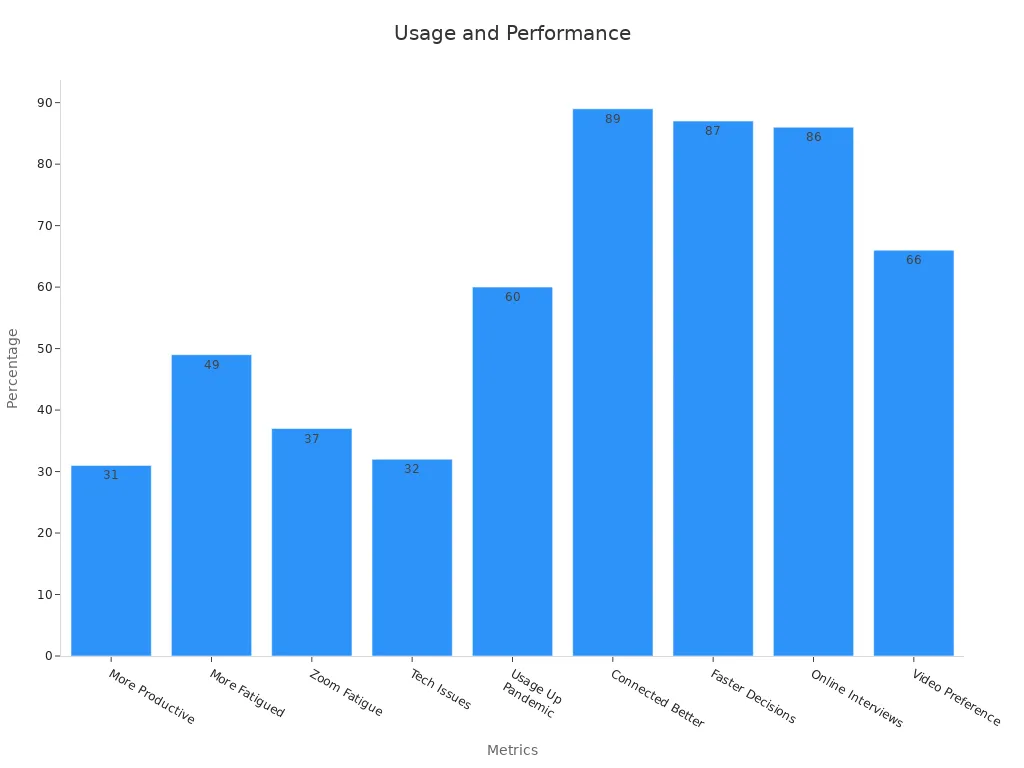
Creating a hybrid classroom that works for everyone requires the right tools. These tools help you connect with students in-person and online, making sure no one feels left out. For example, studies show that student engagement depends on many factors, including social and environmental conditions. By using hybrid classroom equipment, you can address these factors and boost participation. Researchers compared fully remote and hybrid classes and found that the right tools improved interaction for both groups. When you choose the right equipment, you create a space where learning feels seamless for everyone.
Get good microphones so everyone can hear clearly. This helps both in-person and online students stay involved.
Use classroom speakers to make sound even for all. This helps students hear better and stay focused.
Add high-quality cameras with adjustable stands for clear video. This helps online students see and join the class easily.
Try digital tools like smart whiteboards and tablets with pens. These tools make teamwork fun and keep students interested.
Make sure the internet works well and have backup power. This avoids problems and keeps learning smooth for everyone.
Clear and reliable audio is the backbone of any hybrid classroom. Without it, communication breaks down, and students—whether in-person or remote—struggle to stay engaged. By investing in the right audio tools, you can create an environment where every voice is heard and understood.
A high-quality microphone ensures that your voice reaches every student clearly, no matter where they are. Poor audio quality often leads to interruptions, frustration, and disengagement. With advanced microphones, you can eliminate these issues and maintain a smooth flow of communication.
Modern microphones come with features like beamforming technology, which focuses on your voice while filtering out background noise. Noise cancellation further enhances clarity, ensuring that students hear only what matters. Professional-grade systems also capture every voice in the room, making group discussions more inclusive.
Benefits of high-quality microphones:
Beamforming technology targets the speaker’s voice.
Noise cancellation reduces distractions.
Clear audio improves collaboration and understanding.
For example, the University of Utah implemented Rocware’s AV solutions in their hybrid classrooms. Faculty and students praised the improved audio quality and ease of use, which led to better engagement. Similarly, the University of New Hampshire adopted Shure audio systems, which required minimal interaction from teachers while delivering exceptional sound clarity. These success stories highlight the importance of investing in reliable hybrid classroom equipment.
Integrated classroom speakers ensure that sound is evenly distributed throughout the room. This consistency allows in-person students to hear lessons clearly, regardless of where they sit. Dynamic sound-field systems, which combine microphones with strategically placed speakers, take this a step further by delivering sound at an optimal volume.
Research shows that such systems improve student attention and participation. When every student can hear instructions without straining, they stay more focused and engaged. These speakers also benefit remote learners by ensuring that the teacher’s voice is captured and transmitted clearly through video conferencing tools.
Key advantages of integrated speakers:
Consistent sound delivery across the classroom.
Enhanced focus and participation among students.
Seamless integration with other hybrid classroom equipment.
Teaching in a hybrid classroom often means dealing with distractions, from background noise to technical glitches. Noise-canceling headsets help you stay focused by blocking out external sounds. These headsets also enhance audio clarity, ensuring that your voice comes through clearly to remote students.
For teachers, this tool is invaluable. It creates a quieter, more controlled environment, allowing you to concentrate on delivering lessons effectively. Noise-canceling headsets are especially helpful in noisy settings or when teaching from home.
Pros | Cons |
|---|---|
Excellent noise reduction | Typically more expensive |
Ideal for focused learning | Can be heavier and less portable |
Enhances audio clarity | N/A |
These headsets also benefit students with sensory processing issues by minimizing overwhelming sounds. By creating a calm and focused learning environment, you can ensure that every student feels comfortable and engaged.

Video equipment plays a crucial role in bridging the gap between in-person and remote learners. High-quality visuals ensure that every student, regardless of location, can follow lessons effectively. By investing in the right tools, you can create a more engaging and inclusive hybrid classroom.
A high-definition (HD) camera is essential for capturing clear and detailed visuals. It allows remote students to see the teacher, classroom, and materials as if they were physically present. Blurry or low-quality video can make it difficult for students to stay focused and understand the lesson. With an HD camera, you can eliminate these issues and provide a better learning experience.
Modern HD cameras come with features like auto-focus and wide-angle lenses. These features ensure that the entire classroom is visible, even during group activities. Some cameras also offer pan, tilt, and zoom functions, allowing you to adjust the view as needed. This flexibility makes it easier to adapt to different teaching styles and classroom setups.
Tip: Position your HD camera at eye level to create a more natural and engaging connection with remote students.
Adjustable camera mounts enhance the functionality of your video equipment. They allow you to position your camera at the perfect angle, ensuring that all students have a clear view. These mounts are especially useful in dynamic classroom environments where the setup may change frequently.
Key benefits of adjustable camera mounts include:
Flexibility to adapt to various classroom situations.
Stability through additional weight on the feet.
Easy leveling with a bubble level.
Adjustable platforms that support both landscape and portrait orientations.
Sturdy construction for stability on uneven surfaces.
Enhanced video quality by enabling HD cameras to capture optimal angles.
By using adjustable mounts, you can ensure that your camera remains steady and captures high-quality visuals. This setup improves the overall experience for remote learners and helps maintain their engagement.
Document cameras are invaluable for sharing physical materials with your students. These devices allow you to display textbooks, worksheets, and other resources in real-time. Remote students can view the same materials as those in the classroom, creating a more unified learning experience.
With a document camera, you can zoom in on specific details, such as diagrams or handwritten notes. This feature is particularly helpful for subjects like math and science, where visual clarity is essential. Some models also come with annotation tools, enabling you to highlight key points directly on the screen.
Note: Place your document camera on a stable surface to avoid shaky visuals and ensure a smooth presentation.
Incorporating these video tools into your hybrid classroom equipment setup can significantly enhance the learning experience. Clear visuals and flexible setups make it easier for all students to stay engaged and understand the material.
Interactive digital tools play a vital role in keeping students engaged in hybrid classrooms. These tools not only make lessons more dynamic but also cater to diverse learning styles, ensuring every student feels included.
Digital whiteboards transform traditional teaching methods by enabling real-time collaboration. You can use them to write, draw, or display multimedia content, making lessons more interactive. These tools allow remote students to participate actively by viewing and contributing to the same board as in-person learners.
Studies highlight the effectiveness of digital whiteboards in boosting engagement. For instance, they improve student motivation by up to 11.6% and enhance visual support for 19.1% of students. Teachers also benefit from better organization and communication, which leads to more effective teaching.
Benefit | Percentage Range (Teachers) | Percentage (Students) |
|---|---|---|
Student Motivation | 9.50% - 11.60% | 11.8% |
Visual Support | N/A | 19.1% |
Teacher Organization | 4% - 5.90% | N/A |
By integrating digital whiteboards into your hybrid classroom equipment, you create a space where students feel motivated and connected.
Interactive displays take engagement to the next level by combining touch-screen technology with advanced software. These displays allow you to present lessons in a visually appealing way while encouraging students to interact directly with the content. For example, students can solve problems, annotate texts, or explore virtual simulations.
Research shows that interactive displays increase student engagement by 67% compared to traditional methods. They also improve retention rates, with 83% of students remembering lessons after six months in interactive settings. Additionally, critical thinking scores rise by up to 48% in classrooms that use these tools.
Evidence Type | Findings |
|---|---|
Student Engagement | Increased by 67% in interactive learning compared to traditional methods. |
Retention Rates | 83% retention after six months in interactive settings vs. 32% in traditional lectures. |
Critical Thinking Improvement | Scores improved by 32-48% in interactive environments compared to control groups. |
Incorporating interactive displays into your teaching strategy ensures that students remain interested and retain knowledge effectively.
Stylus-enabled tablets provide teachers with a versatile tool for delivering lessons. You can use these tablets to write notes, draw diagrams, or annotate documents during live sessions. The stylus offers precision, making it easier to explain complex concepts visually.
These tablets also support personalized feedback, which enhances student engagement. Learning analytics from these devices allow you to tailor lessons to individual needs, creating a more inclusive environment. Additionally, they enable seamless transitions between in-person and remote teaching, ensuring all students receive the same quality of education.
Tip: Use stylus-enabled tablets to create interactive quizzes or polls. This approach encourages participation and helps you gauge student understanding in real-time.
By leveraging these digital tools, you can foster a more engaging and effective hybrid classroom environment.
Technology plays a vital role in hybrid classrooms, bridging the gap between in-person and remote learners. By selecting the right software and platforms, you can create an environment that fosters collaboration, engagement, and seamless learning experiences.
Video conferencing tools are essential for connecting students across different locations. These platforms allow you to conduct live lessons, share screens, and interact with students in real time. Popular options like Zoom, Microsoft Teams, and Google Meet offer features such as breakout rooms, virtual whiteboards, and recording capabilities.
Statistics highlight the effectiveness of video conferencing tools in hybrid settings:
Statistic | Value |
|---|---|
87% of team members say video calling speeds up decision-making | 87% |
66% of candidates prefer video conferencing over other tools | 66% |
60% of people use video tools more than before the pandemic | 60% |
While these tools enhance connectivity, they also come with challenges like "Zoom fatigue" and technical issues. To minimize these barriers, ensure your hybrid classroom equipment includes reliable internet and user-friendly platforms.

An LMS simplifies the management of course materials, assignments, and assessments. Platforms like Moodle, Canvas, and Blackboard provide centralized access to resources, making it easier for students to stay organized. These systems also support hybrid learning by offering flexibility and scalability.
Benefits of using an LMS:
Enhanced communication and interaction.
Tools for evaluation, feedback, and data analysis.
Educational institutions increasingly rely on LMS platforms to future-proof their curricula. By integrating an LMS into your hybrid classroom setup, you can ensure that students receive consistent support, regardless of their location.
Collaboration tools encourage active participation and teamwork among students. Platforms like Brightspace, Padlet, and Miro allow students to share ideas, work on projects, and engage in peer assessments.
Case studies demonstrate the impact of these tools:
Institution | Collaboration Tool | Engagement Increase | Description |
|---|---|---|---|
Purdue University | Brightspace | 20% | Students actively participated in learning through sharing ideas and forming study groups. |
New England Institute of Technology | Real-time polling | 40% | Increased participation rates through innovative teaching methods and peer assessments. |
Westlake Secondary School | Collaborative analytics | 47% | Improved even participation and project scores through structured role rotations and insights. |
By incorporating collaboration tools into your hybrid classroom equipment, you can create a dynamic learning environment that keeps students engaged and motivated.
Reliable connectivity and infrastructure form the backbone of a successful hybrid classroom. These essentials ensure uninterrupted learning experiences for both in-person and remote students.
A reliable internet connection is critical for hybrid classrooms. It supports smooth video conferencing, real-time collaboration, and access to digital resources. Without it, students may face disruptions that hinder their learning experience. Surveys reveal that fast and stable internet is vital for student success, especially in hybrid learning environments. However, many students struggle with access due to income disparities and caregiving responsibilities.
Key Point | Description |
|---|---|
Network Bandwidth | Essential for concurrent teaching and learning without disruptions. |
Hybrid Classes | Increasing need for stable Wi-Fi as hybrid classes become more common. |
Priority | Reliable internet is a necessity, not just a luxury for educational institutions. |
To bridge the digital divide, schools must prioritize equitable access to high-speed internet. This investment ensures that every student can participate fully in hybrid learning.
Classroom Wi-Fi extenders enhance connectivity by expanding the reach of wireless networks. These devices are particularly useful in large campuses or buildings with thick walls that block signals. Wi-Fi HaLow technology, for example, provides consistent connectivity across multiple classrooms. It also supports IoT devices like environmental sensors, which optimize learning spaces by monitoring conditions such as temperature and air quality.
Benefit | Description |
|---|---|
Enhanced Connectivity | Extends wireless networks within educational institutions. |
Support for IoT Devices | Enables sensors to monitor classroom conditions and improve learning spaces. |
Low Power Consumption | Reduces operational costs for maintaining extensive wireless networks. |
By integrating Wi-Fi extenders into your hybrid classroom equipment, you can ensure seamless connectivity for all students.
Power outages can disrupt hybrid classrooms, cutting off internet access and halting lessons. Backup power solutions prevent these interruptions by providing emergency energy. Generator systems convert fuel into electricity, ensuring operations continue during outages. Fuel cells offer a more efficient alternative, supporting decarbonization goals while maintaining reliability. Battery Energy Storage Systems (BESS) store electricity for peak times or emergencies, enhancing stability in energy supply.
Generator Systems: Essential for maintaining operations during outages.
Fuel Cells: Efficient and environmentally friendly energy conversion.
Battery Energy Storage Systems (BESS): Provide stability and reliability during peak times or outages.
Investing in backup power solutions ensures that your hybrid classroom remains functional, even during unexpected disruptions.
Choosing the right hybrid classroom equipment transforms learning into an inclusive and engaging experience. Tools like high-quality microphones, digital boards, and reliable internet connections ensure clear communication and seamless collaboration. Flexible solutions accommodate diverse learning styles, while cost-efficient setups benefit schools financially. These tools also expand access to education, reaching students in remote locations. By investing in equipment tailored to your classroom's needs, you create an environment where every student thrives.